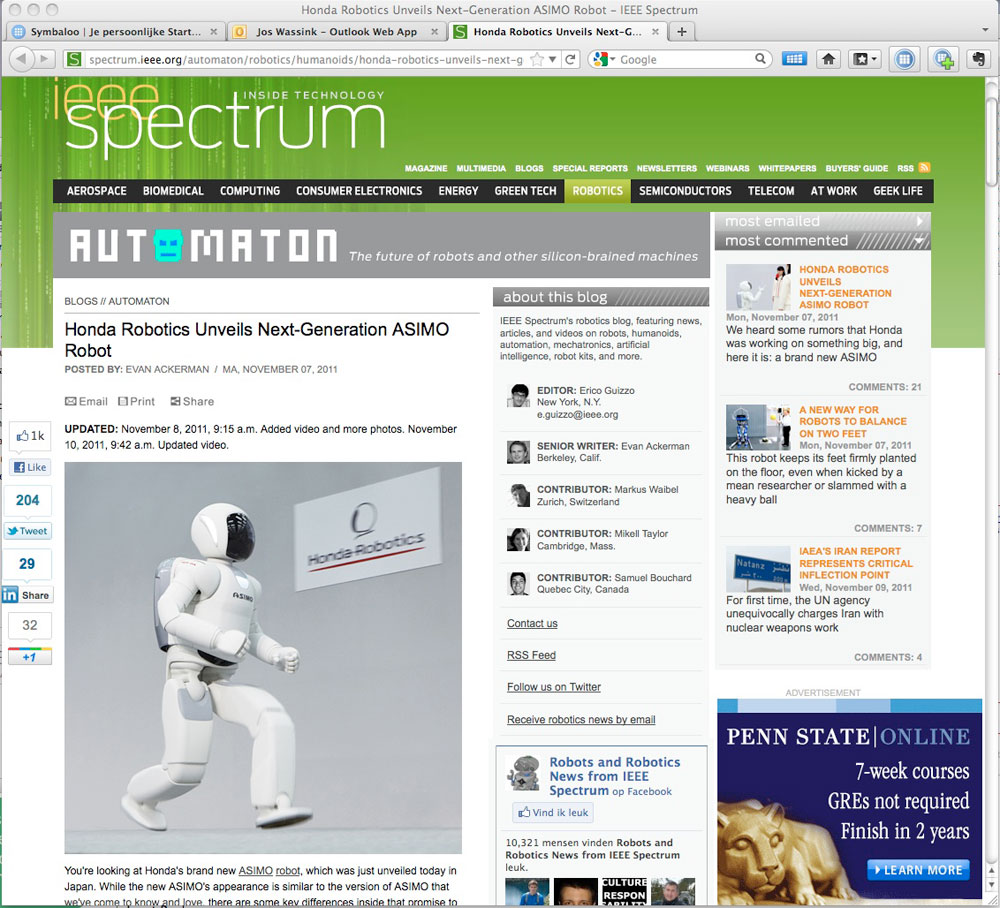He can run, hop on one leg, recognize voices when people talk at the same time, and even pour you a drink. Meet the next generation Asimo robot, introduced by Honda.
Asimo made a grand entrance during the press conference, pushing a cart with a bottle and glass on it. He then carefully opened the bottle and poured juice into the glass. He was also shown running around and even hopping on one leg. Was the most important update of the robot since 2007 impressive?
“Absolutely. It’s incredibly difficult to make such a robot, and Honda has put lots of work into it,” says robotics expert, Dr. Martijn Wisse (3mE). “They had to make sure that all the pieces have just enough strength, so that it doesn’t weigh too much.” Wisse was also impressed with the hopping on one leg: “Asimo jumps and knows where it will land. The robot’s designers made sure of this, because the robot knows where every body part is all times. This is also the case with robots that are used in factories, and it demands lots of energy and control theory.”
But Wisse wonders if this is necessary. “They could’ve used a different approach to making the robot act more human-like,” he suggests. “We can hop on one leg as well, but we do not have to know exactly where we will land.” And Wisse knows what he is talking about, as he created Denise, a robot that can walk in almost the same way as we humans do. There is however great differences between us, Denise and Asimo. When Asimo runs, he bends his legs, almost as if crouching; nevertheless, Asimo can run as fast as 9 kph.
Professor of man-machine interaction, Leon Rothkrantz, praises Asimo’s stability, yet he also wonders if it can indeed interact accurately with people: “Honda states that he could recognize voices when people are talking to him at the same time. I doubt that. We work on speech recognition, and I cannot imagine that Asimo knows who is saying what when several people are talking to him in a hallway. That is extremely difficult for robots. There are microphones in its ears, and we know that speech recognition is more accurate when one talks close to the microphone.”
Honda stresses that the robot could also be used to help elderly people. “I don’t think the robot will be used in elderly homes, though,” Wisse says. “Although the robots aren’t for sale yet, they must be very expensive, and elderly homes are specially made for people in wheelchairs; therefore, such a robot should not necessarily have legs, but rather could also move on wheels. In future I think we will see more and more robots. Robots as vacuum cleaners and lawnmowers are already being sold. Next, robots will be used in the fruit cultivation business, to, for example, put tomatoes in boxes. And after that perhaps as butlers. But it may take decades before this happens.”
For research purposes, Prof. Rothkrantz and his team recently bought a Nao humanoid, developed by Aldebaran Robotics, a French company. “It’s supposed to be very stable, but we discovered it has serious stability problems,” the professor says. “It falls down a lot, although on paper and in video releases it works perfectly. I therefore wonder if Asimo will be as great as Honda says it is. We will only find out when we test it.”
Als de bouwradio nooit was ontworpen, had Van Leeuwen (23) een heel ander bachelor-eindproject gedaan bij IO. Maar nu is de bouwwereld zomaar een robuuste radio én koffiemachine rijker. Hoewel, die laatste bestaat alleen op papier – de presentatieposter van de IO’er, om precies te zijn.
“Bouwvakkers luisteren naar de radio. Altijd. Ze slepen die dingen mee naar de bouwplaats, maar daar beschadigen ze natuurlijk gemakkelijk, dus bouwen ze er zelf vaak kooiconstructies omheen. Daarop bedacht Perfect Pro, het bedrijf voor wie ik mijn eindproject deze zomer deed, de bouwradio. Robuust, stoer, en eenvoudig in gebruik. Toen dacht ik: wat is behalve die radio, ook een kenmerkend product voor bouwvakkers? Koffie, dus.” Van Leeuwen dook de bouwplaats op, praatte met bouwvakkers, en ontdekte dat ze voor elk ‘bakkie pleur’ doodleuk in hun bouwkeet gaan zitten – of soms zelfs speciaal naar de benzinepomp rijden. “Ze houden veel pauze”, lacht de – inmiddels – masterstudent integrated product design. “Dat moest flexibeler kunnen, met een apparaat dat ze gewoon buiten kunnen neerzetten.”
De ‘Perfect Brew’ die van zijn tekentafel kwam, heeft een handvat, een afneembaar waterreservoir en geen kan, maar losse koppen die in de zijkant van het apparaat zitten geklemd. Zo tap je dus gemakkelijk even gauw een los ‘bakkie’. “Bouwvakkers gaan er gezellig in een groepje omheen zitten, wat ’s zomers dus gewoon buiten kan zonder dat je met een thermoskan hoeft te slepen.”
Van Leeuwen vatte zijn eindproject vooral op als een echte ontwerpopdracht, de uitgelezen kans om intensief aan het tekenen te slaan. “Het bedrijf vond het idee om iets met koffie te doen super”, zegt hij. “Maar: elk knopje is er voor bouwvakkers één teveel. Het moest dus een supersimpel no-nonsense-apparaat zijn. Het mijne was eigenlijk te ingewikkeld.”
Hij sleepte er een 7,5 mee binnen, maar marktwaarde lijkt zijn product vooralsnog niet te hebben. Geen punt, want de IO’er heeft zijn roeping gevonden. “Ik volg nu het vak domestic applience. Daarvoor ontwerp ik ook huishoudelijke producten, maar meer consumentgericht. Nu wil ik iets maken dat wél goed op de markt is te zetten.”



Comments are closed.